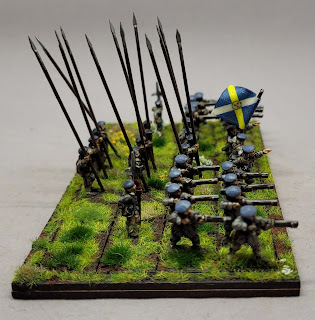Auxiliary Regiment of the City of Bristol Trained Band
Why has this regiment got a 'Parliamentarian' tag and a 'Royalist' tag I hear you wonder?
Originally raised by the good citizens of Brizzle, in 1638 they consisted of 300 men armed with 210 muskets and 90 corslets; many of these men would venture north to fight in the Bishops Wars the following year.
As the country edged closer and closer to Civil War, Bristol was trying to remain resolutely neutral. When Essex marched on the city the city governance accepted the inevitable and allowed Essex's men to enter Bristol. So the Bristol Trained Bands became 'parliamentarian'. At the outbreak of war the Trained Band was commanded by Colonel Andres Charleton.
When Bristol fell to the Royalists the Regiment changed allegiance. The Trained Band would pretty much remain Bristol's garrison regiment regardless of which faction was in control.
By 1645 there were two regiments of the, now Royalist, Trained Band in the city: they were commanded by Colonel Thomas Colston (a statue of his nephew has featured prominently in the news recently) and Colonel John Taylor. Taylor was killed in Fairfax's assault on Bristol in 1645.
Symonds noted that Taylor's Regiment carried white flags with heart devices, and the motto 'Pro Deo et Rege' at the top. I did wonder if this motto was added to the original flag to distinguish their change of allegiance, but as Taylor's Auxiliaries were raised in 1644, when Brizzle was Royalist, it seems unlikely.
There are no known issues of coats to the Bristol Trained Bands; I have depicted them wearing civilian clothes.
Originally raised by the good citizens of Brizzle, in 1638 they consisted of 300 men armed with 210 muskets and 90 corslets; many of these men would venture north to fight in the Bishops Wars the following year.
As the country edged closer and closer to Civil War, Bristol was trying to remain resolutely neutral. When Essex marched on the city the city governance accepted the inevitable and allowed Essex's men to enter Bristol. So the Bristol Trained Bands became 'parliamentarian'. At the outbreak of war the Trained Band was commanded by Colonel Andres Charleton.
When Bristol fell to the Royalists the Regiment changed allegiance. The Trained Band would pretty much remain Bristol's garrison regiment regardless of which faction was in control.
By 1645 there were two regiments of the, now Royalist, Trained Band in the city: they were commanded by Colonel Thomas Colston (a statue of his nephew has featured prominently in the news recently) and Colonel John Taylor. Taylor was killed in Fairfax's assault on Bristol in 1645.
Symonds noted that Taylor's Regiment carried white flags with heart devices, and the motto 'Pro Deo et Rege' at the top. I did wonder if this motto was added to the original flag to distinguish their change of allegiance, but as Taylor's Auxiliaries were raised in 1644, when Brizzle was Royalist, it seems unlikely.
There are no known issues of coats to the Bristol Trained Bands; I have depicted them wearing civilian clothes.
If you enjoyed reading this, or any of the other posts, please consider supporting the blog.
Thanks.














I've been reading through all your blog entries, all of the units look great. What base sizes are you using? I think I'm going a similar route with a deeper pike block with smaller shot bases.
ReplyDeleteThanks.
DeleteMy Quick answer: see https://www.keepyourpowderdry.co.uk/2018/03/basing.html